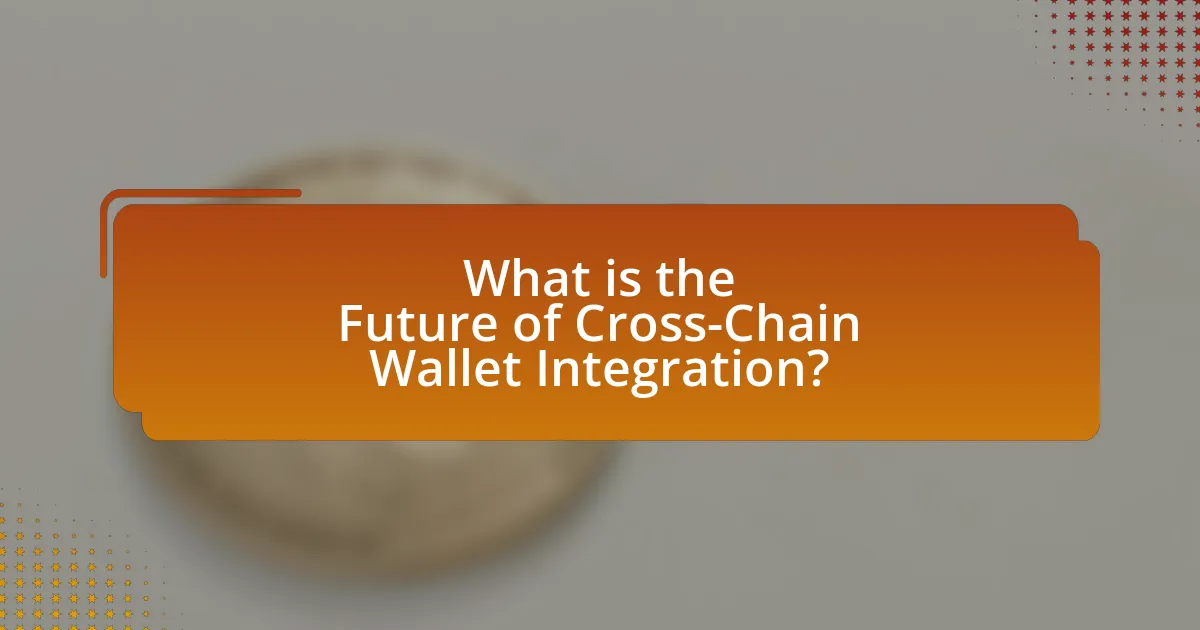The article focuses on the future of cross-chain wallet integration, highlighting its significance in enhancing interoperability among various blockchain networks. It discusses how cross-chain wallets function, the technologies enabling their operation, and the benefits they offer, such as improved user experience and economic advantages. Additionally, the article addresses the challenges faced by cross-chain wallets, including security concerns and regulatory issues, while examining market trends and leading companies in this space. Best practices for using cross-chain wallets and tips for enhancing their usability are also provided, emphasizing the importance of security and user-friendly interfaces.

What is the Future of Cross-Chain Wallet Integration?
The future of cross-chain wallet integration is poised for significant growth and innovation, driven by the increasing demand for interoperability among various blockchain networks. As decentralized finance (DeFi) and non-fungible tokens (NFTs) gain traction, cross-chain wallets will facilitate seamless transactions across different blockchains, enhancing user experience and accessibility. According to a report by Chainalysis, the total value locked in DeFi protocols reached over $100 billion in 2021, highlighting the necessity for wallets that can operate across multiple platforms. This trend indicates that cross-chain wallet integration will become essential for users seeking to manage diverse digital assets efficiently.
How does Cross-Chain Wallet Integration function?
Cross-Chain Wallet Integration functions by enabling users to manage multiple cryptocurrencies across different blockchain networks within a single wallet interface. This integration utilizes protocols such as atomic swaps and cross-chain bridges, which facilitate the transfer of assets between disparate blockchains without the need for intermediaries. For instance, atomic swaps allow users to exchange cryptocurrencies directly from their wallets by leveraging smart contracts that ensure the transaction’s security and integrity. Additionally, cross-chain bridges connect various blockchain ecosystems, allowing for seamless asset transfers and interoperability. This functionality is crucial as it enhances user experience and expands the usability of digital assets across diverse platforms.
What technologies enable Cross-Chain Wallet Integration?
Cross-chain wallet integration is enabled by technologies such as atomic swaps, blockchain interoperability protocols, and decentralized exchanges (DEXs). Atomic swaps allow for the direct exchange of cryptocurrencies across different blockchains without the need for a centralized intermediary, facilitating seamless transactions. Blockchain interoperability protocols, like Polkadot and Cosmos, provide frameworks that enable different blockchains to communicate and share data, enhancing the functionality of cross-chain wallets. Additionally, decentralized exchanges facilitate trading between different cryptocurrencies, further supporting cross-chain transactions by allowing users to swap assets across various blockchain networks.
How do different blockchain protocols interact in Cross-Chain Wallets?
Different blockchain protocols interact in Cross-Chain Wallets through interoperability mechanisms that enable the transfer of assets and data across distinct blockchain networks. These mechanisms often utilize technologies such as atomic swaps, which allow for peer-to-peer exchanges without the need for a centralized intermediary, and wrapped tokens, which represent assets from one blockchain on another blockchain. For instance, the Ethereum blockchain can create wrapped Bitcoin (WBTC), allowing Bitcoin to be used within Ethereum’s ecosystem. Additionally, protocols like Polkadot and Cosmos facilitate cross-chain communication by establishing a shared security model and enabling different blockchains to interoperate seamlessly. This interaction is crucial for enhancing liquidity and expanding the usability of digital assets across multiple platforms.
What are the potential benefits of Cross-Chain Wallet Integration?
Cross-Chain Wallet Integration offers enhanced interoperability among different blockchain networks, allowing users to manage multiple cryptocurrencies within a single wallet interface. This integration simplifies transactions by enabling seamless transfers between various blockchains, reducing the need for multiple wallets and minimizing transaction fees. Additionally, it increases liquidity by allowing users to access a broader range of assets and decentralized applications across different platforms. According to a report by Chainalysis, cross-chain solutions can significantly improve user experience and engagement in decentralized finance (DeFi) by facilitating easier access to diverse financial services.
How does Cross-Chain Wallet Integration enhance user experience?
Cross-Chain Wallet Integration enhances user experience by allowing seamless transactions across multiple blockchain networks. This integration eliminates the need for users to manage separate wallets for different cryptocurrencies, simplifying the process of sending and receiving assets. For instance, users can easily swap tokens from Ethereum to Binance Smart Chain without the hassle of transferring funds between different wallets. Additionally, cross-chain functionality increases liquidity and access to a broader range of decentralized applications, enabling users to engage with diverse financial services and investment opportunities. This streamlined approach not only saves time but also reduces the complexity often associated with managing multiple wallets, ultimately leading to a more efficient and user-friendly experience.
What economic advantages does Cross-Chain Wallet Integration provide?
Cross-Chain Wallet Integration provides significant economic advantages by enabling users to transact across multiple blockchain networks seamlessly. This interoperability reduces transaction costs and time, as users can avoid the fees associated with converting assets between different blockchains. For instance, a study by the Cambridge Centre for Alternative Finance indicates that cross-chain solutions can lower transaction fees by up to 30% compared to traditional methods. Additionally, this integration enhances liquidity by allowing assets to move freely between networks, increasing market efficiency and providing users with more trading opportunities.
What challenges does Cross-Chain Wallet Integration face?
Cross-Chain Wallet Integration faces significant challenges, primarily related to interoperability, security, and user experience. Interoperability issues arise from the diverse protocols and standards across different blockchain networks, making seamless asset transfers complex. Security challenges include the risk of vulnerabilities in smart contracts and potential exploits during cross-chain transactions, which can lead to asset loss. Additionally, user experience is often hindered by the complexity of managing multiple wallets and understanding cross-chain functionalities, which can deter mainstream adoption. These challenges highlight the need for robust solutions to enhance the effectiveness and safety of cross-chain wallet integration.
What security concerns are associated with Cross-Chain Wallets?
Cross-chain wallets face several security concerns, primarily due to their complexity and the interaction between different blockchain networks. One major concern is the risk of smart contract vulnerabilities, as cross-chain wallets often rely on smart contracts to facilitate transactions across different blockchains. These vulnerabilities can be exploited by attackers, leading to potential loss of funds.
Additionally, cross-chain wallets may expose users to risks associated with centralized exchanges if they require users to trust a third party for asset swaps. This reliance can lead to issues such as hacking incidents or fraud, as seen in various high-profile exchange breaches. Furthermore, the lack of standardization across different blockchain protocols can create compatibility issues, increasing the likelihood of errors during transactions, which can also result in financial loss.
These concerns highlight the need for robust security measures and thorough audits of the underlying technology to mitigate risks associated with cross-chain wallet usage.
How do regulatory issues impact Cross-Chain Wallet Integration?
Regulatory issues significantly impact cross-chain wallet integration by creating compliance challenges that can hinder development and adoption. These challenges arise from varying regulations across jurisdictions, which can affect how wallets interact with multiple blockchain networks. For instance, regulations concerning anti-money laundering (AML) and know your customer (KYC) requirements can complicate the integration process, as wallet providers must ensure they comply with the laws of each jurisdiction they operate in. Additionally, the lack of a unified regulatory framework can lead to uncertainty, discouraging investment and innovation in cross-chain technologies. This regulatory landscape can also influence user trust and the overall market acceptance of cross-chain wallets, as users may be wary of potential legal repercussions associated with using non-compliant services.
How is the market evolving for Cross-Chain Wallet Integration?
The market for Cross-Chain Wallet Integration is rapidly evolving due to increasing demand for interoperability among blockchain networks. This evolution is driven by the growing number of decentralized finance (DeFi) applications and the need for users to manage assets across multiple chains seamlessly. According to a report by Chainalysis, the total value locked in DeFi protocols reached over $80 billion in 2021, highlighting the necessity for wallets that can facilitate cross-chain transactions. Additionally, advancements in technology, such as atomic swaps and cross-chain bridges, are enhancing the functionality and security of these wallets, making them more appealing to users. As a result, major wallet providers are investing in cross-chain capabilities, further accelerating market growth.
What trends are shaping the future of Cross-Chain Wallets?
The future of cross-chain wallets is being shaped by several key trends, including increased interoperability, enhanced security measures, and the rise of decentralized finance (DeFi). Interoperability is crucial as it allows users to manage assets across multiple blockchain networks seamlessly, which is becoming essential as the number of blockchain platforms grows. Enhanced security measures, such as multi-signature wallets and biometric authentication, are being implemented to protect users’ assets from hacks and unauthorized access, addressing the growing concerns around security in the crypto space. Additionally, the rise of DeFi is driving demand for cross-chain wallets, as users seek to access various decentralized applications and services that require interaction with multiple blockchains. These trends indicate a shift towards more user-friendly, secure, and versatile wallet solutions in the evolving landscape of cryptocurrency.
Which companies are leading the way in Cross-Chain Wallet Integration?
Companies leading the way in Cross-Chain Wallet Integration include Coinbase, Binance, and Trust Wallet. Coinbase has developed a user-friendly interface that supports multiple cryptocurrencies across different blockchains, enhancing accessibility for users. Binance offers a multi-chain wallet that allows seamless transactions between various blockchain networks, demonstrating its commitment to cross-chain functionality. Trust Wallet, acquired by Binance, supports a wide range of tokens and enables users to interact with decentralized applications across different chains, further solidifying its position in the market. These companies are recognized for their innovative approaches and significant market presence in the cross-chain wallet space.
What are the best practices for using Cross-Chain Wallets?
The best practices for using cross-chain wallets include ensuring security through strong passwords and two-factor authentication, regularly updating wallet software, and verifying transaction details before execution. Security is paramount, as cross-chain wallets often handle multiple cryptocurrencies, making them attractive targets for hackers. According to a report by CipherTrace, over $1.9 billion was lost to cryptocurrency theft in 2020, highlighting the need for robust security measures. Additionally, users should familiarize themselves with the specific features and limitations of their chosen wallet, as different wallets may support varying numbers of blockchains and tokens. Regularly backing up wallet data is also crucial to prevent loss of access to funds.
How can users ensure the security of their Cross-Chain Wallets?
Users can ensure the security of their Cross-Chain Wallets by implementing strong security practices such as enabling two-factor authentication (2FA), using hardware wallets, and regularly updating software. Two-factor authentication adds an extra layer of security by requiring a second form of verification, making unauthorized access more difficult. Hardware wallets store private keys offline, significantly reducing the risk of online hacks. Regular software updates ensure that users benefit from the latest security patches and features, protecting against vulnerabilities. According to a report by the Cybersecurity & Infrastructure Security Agency, using these methods can reduce the likelihood of successful cyberattacks on digital wallets.
What tips can enhance the usability of Cross-Chain Wallets?
To enhance the usability of cross-chain wallets, users should prioritize intuitive user interfaces, robust security features, and seamless integration with multiple blockchain networks. Intuitive user interfaces simplify navigation and transaction processes, making it easier for users to manage assets across different chains. Robust security features, such as multi-signature authentication and biometric verification, protect users from potential threats and fraud. Seamless integration with multiple blockchain networks ensures that users can easily transfer assets without encountering compatibility issues, thereby improving overall user experience. These elements collectively contribute to a more efficient and user-friendly cross-chain wallet experience.


